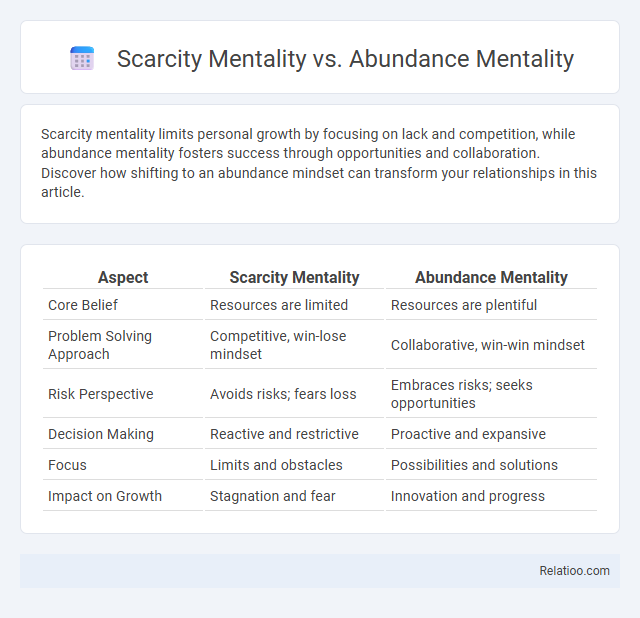Scarcity mentality limits personal growth by focusing on lack and competition, while abundance mentality fosters success through opportunities and collaboration. Discover how shifting to an abundance mindset can transform your relationships in this article.
Table of Comparison
| Aspect | Scarcity Mentality | Abundance Mentality |
|---|---|---|
| Core Belief | Resources are limited | Resources are plentiful |
| Problem Solving Approach | Competitive, win-lose mindset | Collaborative, win-win mindset |
| Risk Perspective | Avoids risks; fears loss | Embraces risks; seeks opportunities |
| Decision Making | Reactive and restrictive | Proactive and expansive |
| Focus | Limits and obstacles | Possibilities and solutions |
| Impact on Growth | Stagnation and fear | Innovation and progress |
Introduction to Scarcity and Abundance Mentality
Scarcity mentality is a mindset rooted in fear and limitation, where individuals perceive resources as finite and competition as necessary for survival, leading to stress and hoarding behaviors. In contrast, abundance mentality embraces the belief that resources and opportunities are plentiful, encouraging collaboration, growth, and positivity. This fundamental shift from scarcity to abundance influences decision-making, relationships, and overall well-being by fostering confidence and generosity instead of anxiety and competition.
Defining Scarcity Mentality: Signs and Origins
Scarcity mentality manifests through fear of lack, envy, and competitive behaviors rooted in perceived resource limitations. Common signs include chronic anxiety over opportunities, hoarding tendencies, and resistance to sharing or collaboration. This mindset often originates from early experiences of deprivation, societal conditioning, or traumatic events that reinforce the belief in limited abundance.
Understanding Abundance Mentality: Core Principles
Abundance mentality centers on the belief that opportunities and resources are plentiful, fostering collaboration, generosity, and optimism in your personal and professional life. This mindset encourages focusing on growth, sharing knowledge, and viewing challenges as chances for innovation rather than competition. Embracing abundance mentality can transform your decision-making process and relationships by promoting trust and long-term success over short-term gains.
Psychological Roots: Why Scarcity Mindsets Develop
Scarcity mentality often develops from early psychological experiences of deprivation, insecurity, or trauma, causing individuals to perceive resources as limited and life as a zero-sum game. This mindset triggers stress responses rooted in the brain's survival instincts, reinforcing fear-based thinking patterns that limit growth and decision-making. Your awareness of these psychological roots can help shift perspectives toward abundance and boundlessness, fostering resilience and opportunity-focused thinking.
Impact on Decision-Making and Relationships
Scarcity mentality limits decision-making by fostering fear and competition, often leading Your relationships to suffer from mistrust and insecurity. Abundance mentality encourages collaboration and open-mindedness, enhancing problem-solving and building stronger, more supportive connections. Boundlessness transcends traditional constraints, empowering innovative choices and fostering deep, expansive relationships rooted in unlimited potential.
Scarcity vs. Abundance in the Workplace
Scarcity mentality in the workplace creates a culture of competition, limited resource sharing, and fear-driven decision-making, which stifles creativity and collaboration. In contrast, abundance mentality fosters openness, knowledge exchange, and mutual support, leading to increased innovation and employee engagement. Organizations that embrace abundance see improved teamwork and sustainable growth, while scarcity-focused environments often experience stagnation and high turnover.
Financial Implications: Wealth and Money Mindsets
Scarcity mentality limits financial growth by fostering fear of loss and hoarding behavior, which restricts opportunities for wealth accumulation. Abundance mentality encourages investment, risk-taking, and generosity, promoting sustained wealth expansion and financial resilience. Boundlessness transcends traditional limitations, enabling innovative wealth creation through limitless thinking and holistic resource utilization.
Overcoming Scarcity Mentality: Practical Strategies
Overcoming scarcity mentality involves shifting focus from limited resources to recognizing abundant opportunities through practices such as gratitude journaling, reframing negative thoughts, and setting clear, achievable goals. Embracing abundance mentality requires cultivating trust in growth and collaboration, while boundlessness extends this mindset by fostering innovation beyond traditional constraints. Practical strategies include mindfulness exercises to reduce fear-based decision making and engaging in community support networks to reinforce a growth-oriented perspective.
Cultivating an Abundance Mindset: Daily Habits
Cultivating an abundance mindset involves daily habits such as practicing gratitude, embracing learning opportunities, and focusing on collaboration rather than competition. You can shift from scarcity mentality, which fixates on limitations, to boundlessness by regularly affirming your goals and seeking diverse perspectives. These practices enhance your resilience, creativity, and ability to attract success in all areas of life.
Long-Term Benefits of Embracing Abundance
Embracing an abundance mentality fosters long-term benefits by promoting collaboration, innovation, and resilience, which contrast sharply with the limiting effects of scarcity mentality's fear-driven decision-making. This mindset shift enables individuals and organizations to unlock boundless opportunities, leading to sustained growth and enriched relationships. Cultivating abundance over scarcity enhances resourcefulness and psychological well-being, driving continuous success over time.

Infographic: Scarcity Mentality vs Abundance Mentality
 relatioo.com
relatioo.com